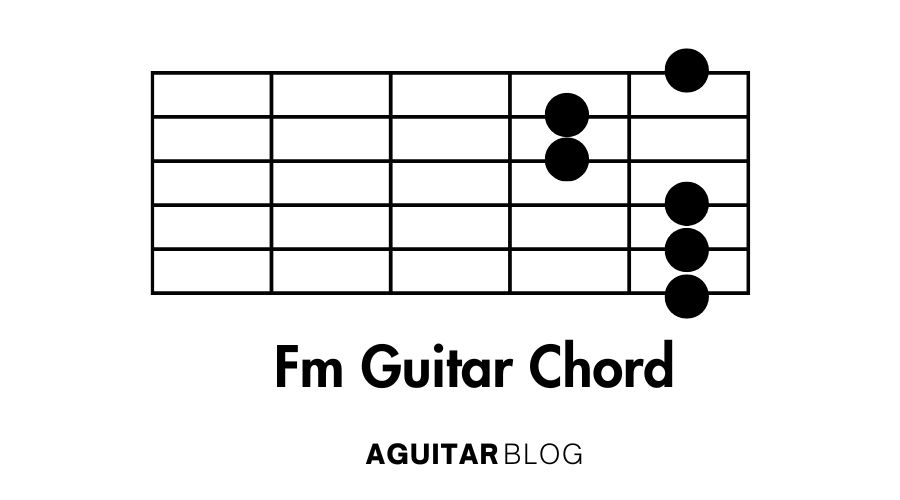Explore the rich sound of the Fm guitar chord with essential techniques and tips for mastery. Whether you’re delving into jazz, rock, or other genres, mastering this chord enhances your musical versatility and depth. Discover how to navigate its unique tones and integrate them into your playing to elevate your guitar skills.
How to play the Fm guitar chord

Playing the Fm (F minor) chord on the guitar can add a melancholic and emotive quality to your music. Here’s a step-by-step guide on how to play the Fm chord:
Standard Position (Barre Chord)
- Index Finger: Barre all the strings at the 1st fret. This means you press down on all the strings using your index finger, covering all six strings across the fretboard.
- Middle Finger: Place your middle finger on the 2nd fret of the G (3rd) string.
- Ring Finger: Place your ring finger on the 3rd fret of the A (5th) string.
- Pinky Finger (optional): You can optionally place your pinky finger on the 3rd fret of the D (4th) string for a fuller sound.
- Strumming: Strum from the A (5th) string down to the high E (1st) string. Make sure all strings ring out clearly.
Tips for Playing
- Barre Technique: Press down firmly with your index finger to ensure all strings are fretted properly.
- Finger Placement: Keep your other fingers close to the frets for clear notes.
- Strumming: Strum gently at first to ensure all strings sound clear. Adjust finger placement if any strings are muted or buzzing.
READ MORE: Mastering the F7 Guitar Chord: A Guide for Guitarists
FAQs Fm guitar chord
What notes make up the Fm chord?
The Fm chord consists of the notes F, Ab, and C.
What are common variations of the Fm chord?
Common variations of the Fm (F minor) chord on guitar include:
- Barre chord at the 1st fret.
- Open position using fingers on the 1st fret.
- Easier version with simplified finger placement.
- Alternative fingerings around the 1st fret for comfort and sound variation.
What is the easy version of the F minor chord?
The easiest version of the F minor (Fm) chord on the guitar is typically played using a simplified finger placement, avoiding the need for a full barre chord. Here’s one common variation:
- Index Finger: Place your index finger on the 1st fret of the low E (6th) string.
- Middle Finger: Place your middle finger on the 1st fret of the B (2nd) string.
- Ring Finger: Place your ring finger on the 1st fret of the G (3rd) string.
Ensure that you strum from the low E (6th) string to the high E (1st) string, omitting the A (5th) string for this variation.
This simplified version of the Fm chord is easier for beginners to play because it doesn’t require a full barre across all strings. It still maintains the essential notes of the F minor triad (F, Ab, C) and allows for easier finger placement and strumming
How to play FM barre chords on guitar?
To play the FM (F minor) barre chord on guitar:
- Barre all six strings with your index finger at the 1st fret.
- Place your middle finger on the 2nd fret of the G (3rd) string.
- Place your ring finger on the 3rd fret of the A (5th) string.
- Strum from the A string down to the high E string.
Practice maintaining even pressure with your index finger to ensure clear notes across all strings.
What is an FM chord on guitar?
An FM chord on guitar typically refers to an F minor chord. It consists of the notes F, Ab, and C. This chord is played by placing your fingers on specific frets of the guitar strings to create a melancholic and emotive sound characteristic of minor chords.
Where can the Fm chord be used in music?
The Fm chord is versatile and can be used in various music genres, including jazz, rock, blues, and more
What songs use the Fm chord?
Many songs across different genres use the Fm chord. Examples include “Clocks” by Coldplay and “Every Breath You Take” by The Police
Mastering the Fm guitar chord opens up a world of musical possibilities, enriching your playing with its distinct and emotive tones. By honing your technique and understanding its nuances, you’ll enhance your ability to convey a range of emotions through your music, whether it’s in jazz, rock, or any genre you explore. Keep practicing and experimenting with different musical contexts to fully harness the expressive power of the Fm chord in your guitar journey